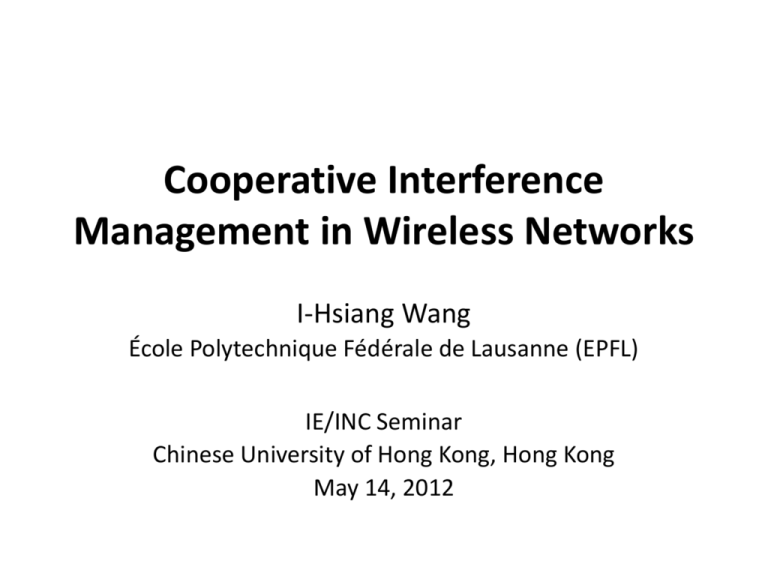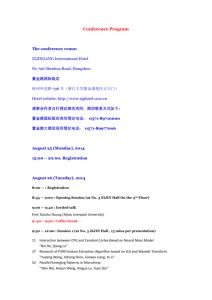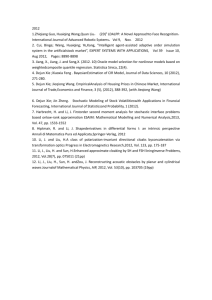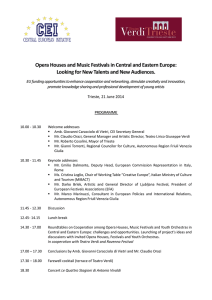View - Institute of Network Coding
advertisement

Cooperative Interference Management in Wireless Networks I-Hsiang Wang École Polytechnique Fédérale de Lausanne (EPFL) IE/INC Seminar Chinese University of Hong Kong, Hong Kong May 14, 2012 Experience with Wireless? Monthly Mobile Data Traffic Skype is so choppy! My e-mail won’t refresh… 18X I need directions now! Why is my tethered connection so slow?! 05/14/12 Wang, IE/INC Seminar, CUHK 1 Past Challenges in Wireless Example: cellular network Mobile Base Station (BS) 1. Fading ✔ 2. Multiplexing ✔ (Multiple Access) Past 15 years: • MIMO • Opportunistic communication • Wideband Systems CDMA, OFDMA System Gain: pertains to point-to-point/single-cell performance 05/14/12 Wang, IE/INC Seminar, CUHK 2 A Current Key Challenge As # of mobile & BS 1. Fading ✔ 2. Multiplexing ✔ 3. Interference Signal not intended to the receiving terminal (intercell) Bad news: capacity of twouser interference channel remains open for 35+ years Performance of today’s wireless system is majorly limited by interference! 05/14/12 Wang, IE/INC Seminar, CUHK 3 Interference: Major Bottleneck • Narrowband system (GSM): – Orthogonalize it – Poor frequency reuse; shortage of resource • Wideband system (CDMA, OFDMA): – Treat it as noise – Degrades if interferences get strong (cell-boundary users) • Opportunities neglected in traditional paradigm… • Cooperation; cooperative interference management 05/14/12 Wang, IE/INC Seminar, CUHK 4 Opportunities in Cellular Systems Information theory: • degree-of-freedom gain • power gain Distributed MIMO Backhaul DSL, Optical Fiber, Microwave virtual Caveat: cooperation is limited 05/14/12 Wang, IE/INC Seminar, CUHK 5 Opportunities in Wireless LAN • Interference • Radios can overhear • Idle or additional devices (femto-cell) • Cooperation Caveat: cooperation is limited 05/14/12 Wang, IE/INC Seminar, CUHK 6 Short Recap • Interference: currently the major bottleneck • Cooperative interference management – Opportunities neglected in traditional paradigm – Cooperation among terminals helps mitigate interference – The rate at which they cooperate, however, is limited • Fundamental information theoretic question: How much capacity gain under limited cooperation? – Answered in this talk! 05/14/12 Wang, IE/INC Seminar, CUHK 7 Overview of Studied Scenarios Canonical Setting: Two Transmitters Two Receivers, Orthogonal Coop. General Setting: Two Sources Two Destinations Coop. over Network Backhaul Downlink Uplink Lens of Information Theory Wireless Arbitrary # of Nodes BS 05/14/12 BS Wang, IE/INC Seminar, CUHK 8 Rest of this talk • Focus on the canonical two-Tx-two-Rx setting • Approximate characterization of capacity region • Gain from limited cooperation – Qualitative interpretation – Quantitative understanding • Optimal scheme in high-SNR regime • Two unicast sessions over layered wireless networks 05/14/12 Wang, IE/INC Seminar, CUHK 9 Gaussian Interference Channel Gaussian Interference Channel (GIC) • All nodes know the whole channel – Direct link: Signal-to-Noise Ratio (SNR) – Cross link: Interference-to-Noise Ratio (INR) • Capacity is open for 35+ years – Capacity region characterized to within 1 bits/s/Hz [Etkin et.al.’07] 05/14/12 Wang, IE/INC Seminar, CUHK 10 GIC with Limited Cooperation Out-of-Band Transmitter Cooperation Out-of-Band Receiver Cooperation • All nodes know the whole channel • Cooperation links are noise-free, – Orthogonal to each other and the interference channel – Of finite capacities and respectively 05/14/12 Wang, IE/INC Seminar, CUHK 11 Capacity to within a Bounded Gap Joint work with David Tse • Rx Cooperation: Capacity region to within 2 bits/s/Hz [W&Tse’09] • Tx Cooperation: Capacity region to within 6.5 bits/s/Hz [W&Tse’10] • The first uniform approximation result on the capacity region of GIC with Rx cooperation or Tx cooperation • As SNR goes to infinity, gap is negligible: Capacity at high SNR! 05/14/12 Wang, IE/INC Seminar, CUHK 12 Nature of the Gain from Coop Receiver Cooperation Symmetric Case Wireless power gain Wireless degree-of-freedom gain Backhaul Linear Region Cooperation is efficient Saturation Region Cooperation is inefficient Focus on the Linear Region 05/14/12 Wang, IE/INC Seminar, CUHK 13 Coop. Efficiency in Int. Mitigation Corollary (DoF Gain) Depending on the channel strength, either • One additional coop bit buys one more bit over-the-air, or power gain degree-of-freedom gain • Two additional coop bits buy one more bit over-the air Slope is either 1 or ½, depending on channel strength 05/14/12 Wang, IE/INC Seminar, CUHK 14 High-SNR Approximate Capacity Capacity per user The same picture for Tx cooperation! Normalized Capacity (by the interference-free capacity) High-SNR Normalized Capacity Without cooperation [Etkin et.al.’07] Normalized Backhaul Capacity With cooperation The same definition for Tx cooperation! 05/14/12 Wang, IE/INC Seminar, CUHK Strength of Interference 15 Linear Deterministic Model ✕ Approximate! Unit Tx power Unit noise power ✕✕ ✕✕✕ ✕ (Roughly speaking), # of bits that is above the noise level Captures the interaction of signals in wireless networks [Avestimehr et.al.’07] 05/14/12 Wang, IE/INC Seminar, CUHK 16 One Cooperation bit buys one bit Tx1 Rx1 Tx2 Rx2 common Slope = 1 private Two cooperation bits buy two more bits 05/14/12 Wang, IE/INC Seminar, CUHK 17 Two Cooperation bits buy one bit Tx1 Rx1 Tx2 Rx2 Slope = 1/2 Two cooperation bits buy one more bit 05/14/12 Wang, IE/INC Seminar, CUHK 18 Near Optimal Coding Scheme Quantize Binning Decode 1 2 Private level Blue: common Red: private 2 1 Private level Quantize • Superposition coding Decode • Quantize-Map-Forward – Common-private split facilitates partial interference cancellation – Private interference is at or below noise level at the unintended receiver 05/14/12 Binning Wang, IE/INC Seminar, CUHK – Quantize at private+noise signal level – Jointly decode message and quantization codeword 19 Uplink-Downlink Reciprocity Primary Downlink Scenario Channel matrix Hermitian Swap two cooperation links Capacity regions are within a bounded gap Dual Uplink Scenario 05/14/12 Wang, IE/INC Seminar, CUHK 20 Reflections Multiple Information Flows over Networks IC with Tx Coop IC with Rx Coop [W & Tse’10] [W & Tse’09] • Just two special cases! – Techniques in the proofs are tailored for specific problems • Single-flow problem: – Solved in the linear deterministic scenario, for arbitrary network topology [Avestimehr et.al.’07] Max Flow = Min Cut • Is there a common principle/approach to solve a richer set of problems? 05/14/12 Wang, IE/INC Seminar, CUHK 21 Multiple-Unicast Wireless Network Wireless Arbitrary # of Nodes • K=1, single unicast [Avestimehr et al.‘07] – Max-Flow = Min-Cut – Random linear coding achieves min-cut • Insights from network coding in wired networks • Extends to single multicast 05/14/12 Wang, IE/INC Seminar, CUHK 22 Two Unicast Sessions Wireless Wired (integer edge capacity) Arbitrary # of Nodes • Two Unicast Wired Networks (directed) – Capacity unknown! • MinCut(si; di) = 1: Capacity characterized [Wang & Shroff IT10] – Cut-set bound is not tight – Routing or random linear network coding no longer suffice – Only a bounded # of edges has to take special operations 05/14/12 Wang, IE/INC Seminar, CUHK 23 Two-Unicast Wired Networks – The region must be one of the two: R2 R2 S (1, 1) T R1 R1 – Necessary and sufficient conditions are given 05/14/12 Wang, IE/INC Seminar, CUHK 24 An Analog in Wireless Two-Unicast • Layered linear deterministic network – MinCut(si; di) = 1, i = 1,2 Example Baseline Capacity? Trivial outer bound Time sharing inner bound Layer 0 05/14/12 Layer 1 Layer 2 Wang, IE/INC Seminar, CUHK 25 Main Result • Layered linear deterministic network – MinCut(si; di) = 1, i = 1,2 – Characterize the two-unicast capacity region – Must be one of the following five R2 R2 R2 2, 1) (0,(0,1)1) (1/(1/ 2,S1) 2(1, 1) (1/ 2, 1) R2 (1/ 2, 1) R P T 1/ 2) T(1,21 12 T (1, 0) R1 R1 T S (1, 1) P T 21 T 12 R2 (1, 1/ 2) (1, 1/ 2) R1 R1 R1 (1, 0) Joint work with S. Kamath and D. Tse 05/14/12 Wang, IE/INC Seminar, CUHK R1 26 Key Idea in the Result Some nodes are special! • Achievability – all nodes do random linear coding, Except 4 of these nodes • Outer Bound – suffices to check their properties No need to check others • Systematic approach to identify them 05/14/12 Wang, IE/INC Seminar, CUHK 27 Conclusion • Cooperative Interference Management – Capacity characterized approximately – Linear vs. Saturation Region – Cooperation Efficiency in Linear Region • 1 Coop bit buys 1 bit over-the-air or • 2 Coop bits buy 1 bit over-the-air – Insights to cellular system design with limited backhaul • General Two-unicast Wireless Networks – Layered linear deterministic network, individual min-cut constrained to be 1: Capacity characterized – General case: open 05/14/12 Wang, IE/INC Seminar, CUHK 28 Thank You! More details can be found at http://sites.google.com/site/ihsiangw/ Email: i-hsiang.wang@epfl.ch




